Functional Characterization and Screening of Promiscuous Kinases and Isopentenyl Phosphate Kinases for the Synthesis of DMAPP via a One-Pot Enzymatic Cascade
Abstract
1. Introduction
2. Results and Discussion
2.1. Cloning and Expression of Promiscuous Kinases
2.2. Characterization of Recombinant Promiscuous Kinases
2.3. Cloning and Expression of Isopentenyl Phosphate Kinase
2.4. Characterization of Recombinant Isopentenyl Phosphate Kinase
2.5. Developing a One-Pot Enzymatic Cascade for the Synthesis of DMAPP
2.6. Optimizing the Conditions of the One-Pot Enzymatic Cascade
3. Materials and Methods
3.1. Strains, Plasmids, Media and Chemicals
3.2. Plasmid Construction
3.3. Heterologous Expression and Purification of Recombinant Enzymes
3.4. Promiscuous Kinase Assay
3.5. Isopentenyl Phosphate Kinase Assay
3.6. Determination of Enzyme Activities and Properties
3.7. Optimizing the Conditions of the Biocatalytic Cascade to Produce DMAPP
3.8. HPLC and Liquid Chromatography–Mass Spectrometry (LC–MS) Analyses
3.9. Statistical Analysis
4. Conclusions
Supplementary Materials
Author Contributions
Funding
Institutional Review Board Statement
Informed Consent Statement
Data Availability Statement
Conflicts of Interest
References
- Chang, M.C.Y.; Keasling, J.D. Production of isoprenoid pharmaceuticals by engineered microbes. Nat. Chem. Biol. 2006, 2, 674–681. [Google Scholar] [CrossRef] [PubMed]
- Cherry, J.; Vickers, C.E.; Peng, B.; Williams, T.C. Recent advances in synthetic biology for engineering isoprenoid production in yeast. Curr. Opin. Chem. Biol. 2017, 40, 7–56. [Google Scholar]
- Christianson, D.W. Unearthing the roots of the terpenome. Curr. Opin. Chem. Biol. 2008, 12, 141–150. [Google Scholar] [CrossRef] [PubMed]
- Lund, S.; Hall, R.; Williams, G.J. An artificial pathway for isoprenoid biosynthesis decoupled from native hemiterpene metabolism. ACS Synth. Biol. 2019, 8, 232–238. [Google Scholar] [CrossRef] [PubMed]
- Bai, N.; Li, G.H.; Luo, S.L.; Du, L.; Hu, Q.Y.; Xu, H.K.; Zhang, K.Q.; Zhao, P.J. Vib-PT, an aromatic prenyltransferase involved in the biosynthesis of vibralactone from Stereum vibrans. Appl. Environ. Microbiol. 2020, 86, e02687-19. [Google Scholar] [CrossRef]
- Liu, C.; Minami, A.; Noike, M.; Toshima, H.; Oikawa, H.; Dairi, T. Regiospecificities and prenylation mode specificities of the fungal indole diterpene prenyltransferases AtmD and PaxD. Appl. Environ. Microbiol. 2013, 79, 7298–7304. [Google Scholar] [CrossRef] [PubMed]
- Bruijn, W.; Levisson, M.; Beekwilder, J.; Berkel, W.; Vincken, J.P. Plant aromatic prenyltransferases: Tools for microbial cell factories. Trends Biotechnol. 2020, 38, 917–934. [Google Scholar] [CrossRef] [PubMed]
- Chen, X.; Mukwaya, E.; Wong, M.S.; Zhang, Y. A systematic review on biological activities of prenylated flavonoids. Pharm. Biol. 2014, 52, 655–660. [Google Scholar] [CrossRef]
- Botta, B.; Vitali, A.; Menendez, P.; Misiti, D.; Monache, G.D. Prenylated flavonoids: Pharmacology and biotechnology. Curr. Med. Chem. 2005, 12, 717–739. [Google Scholar] [CrossRef]
- Ye, R.; Fan, Y.H.; Ma, C.M. Identification and enrichment of α-glucosidase-inhibiting dihydrostilbene and flavonoids from glycyrrhiza uralensis leaves. J. Agric. Food Chem. 2017, 65, 510–515. [Google Scholar] [CrossRef]
- Sun, H.; Wang, D.; Song, X.; Zhang, Y.; Ding, W.; Peng, X.; Zhang, X.; Li, Y.; Ma, Y.; Wang, R.; et al. Natural prenylchalconaringenins and prenylnaringenins as antidiabetic agents: α-glucosidase and α-amylase inhibition and in vivo antihyperglycemic and antihyperlipidemic effects. J. Agric. Food Chem. 2017, 65, 1574–1581. [Google Scholar] [CrossRef] [PubMed]
- Zhao, H.; Guo, Y.; Li, S.; Han, R.; Ying, J.; Zhu, H.; Wang, Y.; Yin, L.; Han, Y.; Sun, L.; et al. A novel anti-cancer agent icaritin suppresses hepatocellular carcinoma initiation and malignant growth through the IL-6/Jak2/Stat3 pathway. Oncotarget 2015, 6, 31927–31943. [Google Scholar] [CrossRef]
- Fan, Y.; Li, S.; Ding, X.; Yue, J.; Jiang, J.; Zhao, H.; Hao, R.; Qiu, W.; Liu, K.; Li, Y.; et al. First-in-class immune-modulating small molecule icaritin in advanced hepatocellular carcinoma: Preliminary results of safety, durable survival and immune biomarkers. Clin. Trial. 2019, 19, 279. [Google Scholar] [CrossRef] [PubMed]
- Wang, P.; Li, C.; Li, X.; Huang, W.; Wang, Y.; Wang, J.; Zhang, Y.; Yang, X.; Yan, X. Complete biosynthesis of the potential medicine icaritin by engineered Saccharomyces cerevisiae and Escherichia coli. Sci. Bull. 2021, 66, 1906–1916. [Google Scholar] [CrossRef]
- Kirby, J.; Keasling, J.D. Biosynthesis of plant isoprenoids: Perspectives for microbial engineering. Annu. Rev. Plant Biol. 2009, 60, 335–355. [Google Scholar] [CrossRef] [PubMed]
- Yang, C.; Gao, X.; Jiang, Y.; Sun, B.; Gao, F.; Yang, S. Synergy between methylerythritol phosphate pathway and mevalonate pathway for isoprene production in Escherichia coli. Metab. Eng. 2016, 37, 79–91. [Google Scholar] [CrossRef] [PubMed]
- Wang, X.; Chen, J.; Zhang, J.; Zhou, Y.; Li, X. Engineering Escherichia coli for production of geraniol by systematic synthetic biology approaches and laboratory-evolved fusion tags. Metab. Eng. 2021, 66, 60–67. [Google Scholar] [CrossRef]
- Martin, V.J.; Pitera, D.J.; Withers, S.T.; Newman, J.D.; Keasling, J.D. Engineering a mevalonate pathway in Escherichia coli for production of terpenoids. Nat. Biotechnol. 2003, 21, 796–802. [Google Scholar] [CrossRef]
- Pitera, D.J.; Paddon, C.J.; Newman, J.D.; Keasling, J.D. Balancing a heterologous mevalonate pathway for improved isoprenoid production in Escherichia coli. Metab. Eng. 2007, 9, 193–207. [Google Scholar] [CrossRef]
- Chatzivasileiou, A.O.; Ward, V.; Edgar, S.M.; Stephanopoulos, G. Two-step pathway for isoprenoid synthesis. Proc. Natl. Acad. Sci. USA 2018, 116, 506–511. [Google Scholar] [CrossRef]
- Clomburg, J.M.; Qian, S.; Tan, Z.; Cheong, S.; Gonzalez, R. The isoprenoid alcohol pathway, a synthetic route for isoprenoid biosynthesis. Proc. Natl. Acad. Sci. USA 2019, 116, 12810–12815. [Google Scholar] [CrossRef] [PubMed]
- Luo, Z.; Liu, N.; Lazar, Z.; Chatzivasileiou, A.; Ward, V.; Chen, J.; Zhou, J.; Stephanopoulos, G. Enhancing isoprenoid synthesis in Yarrowia lipolytica by expressing the isopentenol utilization pathway and modulating intracellular hydrophobicity. Metab. Eng. 2020, 61, 344–351. [Google Scholar] [CrossRef] [PubMed]
- Ward, V.C.A.; Chatzivasileiou, A.O.; Stephanopoulos, G. Cell free biosynthesis of isoprenoids from isopentenol. Biotechnol. Bioeng. 2019, 116, 3269–3281. [Google Scholar] [CrossRef]
- Uchiya, K.I.; Tohsuji, M.; Nikai, T.; Sugihara, H.; Sasakawa, C. Identification and characterization of phoN-Sf, a gene on the large plasmid of Shigella flexneri 2a encoding a nonspecific phosphatase. J. Bacteriol. 1996, 178, 4548–4554. [Google Scholar] [CrossRef] [PubMed]
- Lange, B.M.; Croteau, R. Isopentenyl diphosphate biosynthesis via a mevalonate-independent pathway: Isopentenyl monophosphate kinase catalyzes the terminal enzymatic step. Proc. Natl. Acad. Sci. USA 1999, 96, 13714–13719. [Google Scholar] [CrossRef]
- Dellas, N.; Noel, J.P. Mutation of archaeal isopentenyl phosphate kinase highlights mechanism and guides phosphorylation of additional isoprenoid monophosphates. ACS Chem. Biol. 2010, 5, 589–601. [Google Scholar] [CrossRef]
- Lund, S.; Courtney, T.; Williams, G. Probing the substrate promiscuity of isopentenyl phosphate kinase as a platform for hemiterpene analogue production. Chembiochem 2019, 20, 2217–2221. [Google Scholar] [CrossRef]
- Mabanglo, M.F.; Schubert, H.L.; Chen, M.; Hill, C.P.; Poulter, C.D. X-ray structures of isopentenyl phosphate kinase. ACS Chem. Biol. 2010, 5, 517–527. [Google Scholar] [CrossRef]
- Chen, M.; Poulter, C.D. Characterization of thermophilic archaeal isopentenyl phosphate kinases. Biochemsitry 2010, 49, 207–217. [Google Scholar] [CrossRef]
- Hodgman, C.E.; Jewett, M.C. Cell-free synthetic biology: Thinking outside the cell. Metab. Eng. 2012, 4, 261–269. [Google Scholar] [CrossRef]
- Kwon, S.J.; Mora-Pale, M.; Lee, M.Y.; Dordick, J.S. Expanding nature’s small molecule diversity via in vitro biosynthetic pathway engineering. Curr. Opin. Chem. Biol. 2012, 16, 186–195. [Google Scholar] [CrossRef] [PubMed]
- Tessaro, D.; Pollegioni, L.; Piubelli, L.; D’Arrigo, P.; Servi, S. Systems biocatalysis: An artificial metabolism for interconversion of functional groups. ACS Catal. 2015, 5, 1604–1608. [Google Scholar] [CrossRef]
- Bungaruang, L.; Gutmann, A.; Nidetzky, B. Leloir glycosyltransferases and natural product glycosylation: Biocatalytic synthesis of the C-glucoside nothofagin, a major antioxidant of redbush herbal tea. Adv. Synth. Catal. 2013, 355, 2757–2763. [Google Scholar] [CrossRef] [PubMed]
- Gutmann, A.; Bungaruang, L.; Weber, H.; Leypold, M.; Breinbauer, R.; Nidetzky, B. Towards the synthesis of glycosylated dihydrochalcone natural products using glycosyltransferase-catalysed cascade reactions. Green Chem. 2014, 16, 4417–4425. [Google Scholar] [CrossRef]
- Tani, Y.; Kimura, K.; Mihara, H. Purification and properties of 4-methyl-5-hydroxyethylthiazole kinase from Escherichia coli. Biosci. Biotechnol. Biochem. 2015, 80, 514–517. [Google Scholar] [CrossRef]
- Dellas, N.; Thomas, S.T.; Manning, G.; Noel, J.P. Discovery of a metabolic alternative to the classical mevalonate pathway. Elife 2013, 2, e00672. [Google Scholar] [CrossRef]
- Liu, Y.; Yan, Z.; Lu, X.; Xiao, D.; Jiang, H. Improving the catalytic activity of isopentenyl phosphate kinase through protein coevolution analysis. Sci. Rep. 2016, 6, 24117. [Google Scholar] [CrossRef]
- Liu, H.; Chen, S.L.; Xu, J.Z.; Zhang, W.G. Dual regulation of cytoplasm and peroxisomes for improved a-farnesene production in recombinant Pichia pastoris. ACS Synth. Biol. 2021, 6, 1563–1573. [Google Scholar] [CrossRef]
- Qiu, C.; Liu, Y.; Wu, Y.; Zhao, L.; Pei, J. Biochemical characterization of a novel prenyltransferase from Streptomyces sp. NT11 and development of a recombinant strain for the production of 6-prenylnaringenin. J. Agric. Food Chem. 2021, 69, 14231–14240. [Google Scholar] [CrossRef]
- Nishihara, K.; Kanemori, M.; Kitagawa, M.; Yanagi, H.; Yura, T. Chaperone coexpression plasmids: Differential and synergistic roles of DnaK-DnaJ-GrpE and GroEL-GroES in assisting folding of an allergen of Japanese cedar pollen, Cryj2, in Escherichia coli. Appl. Environ. Microbiol. 1998, 64, 1694–1699. [Google Scholar] [CrossRef]
- Zorn, H.; Li, Q.X. Trends in Food Enzymology. J. Agric. Food Chem. 2017, 65, 4–5. [Google Scholar] [CrossRef] [PubMed]
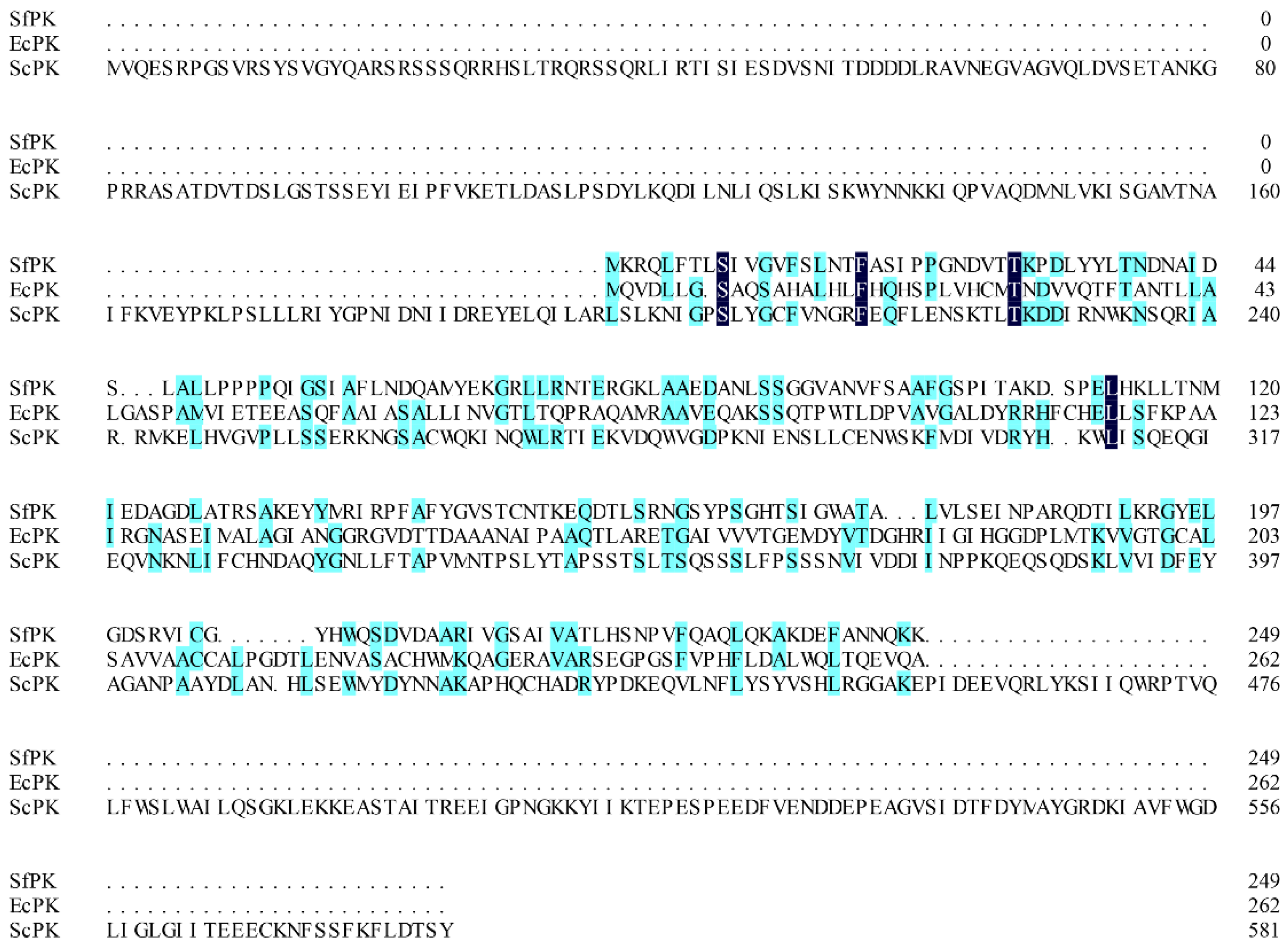
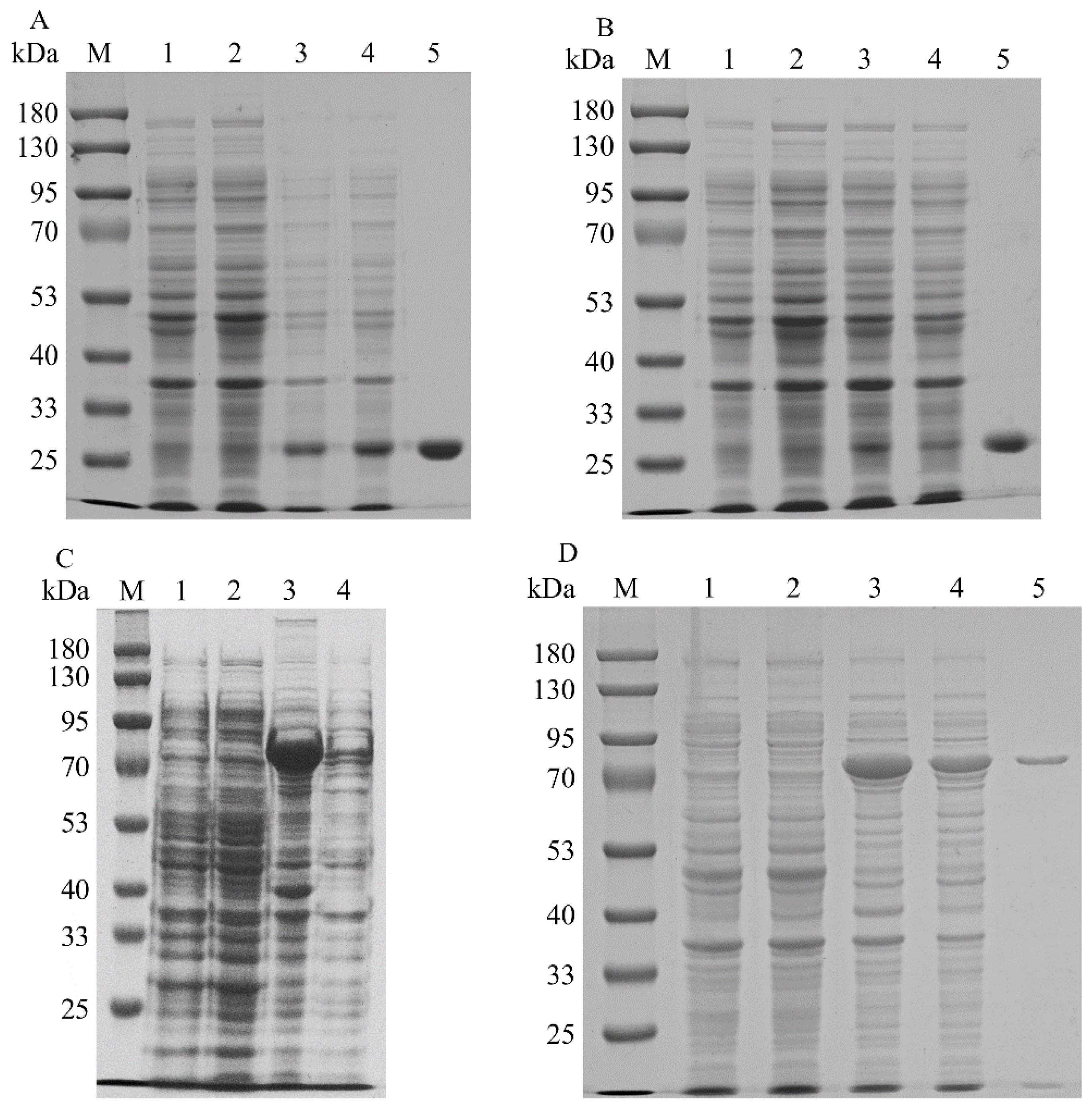
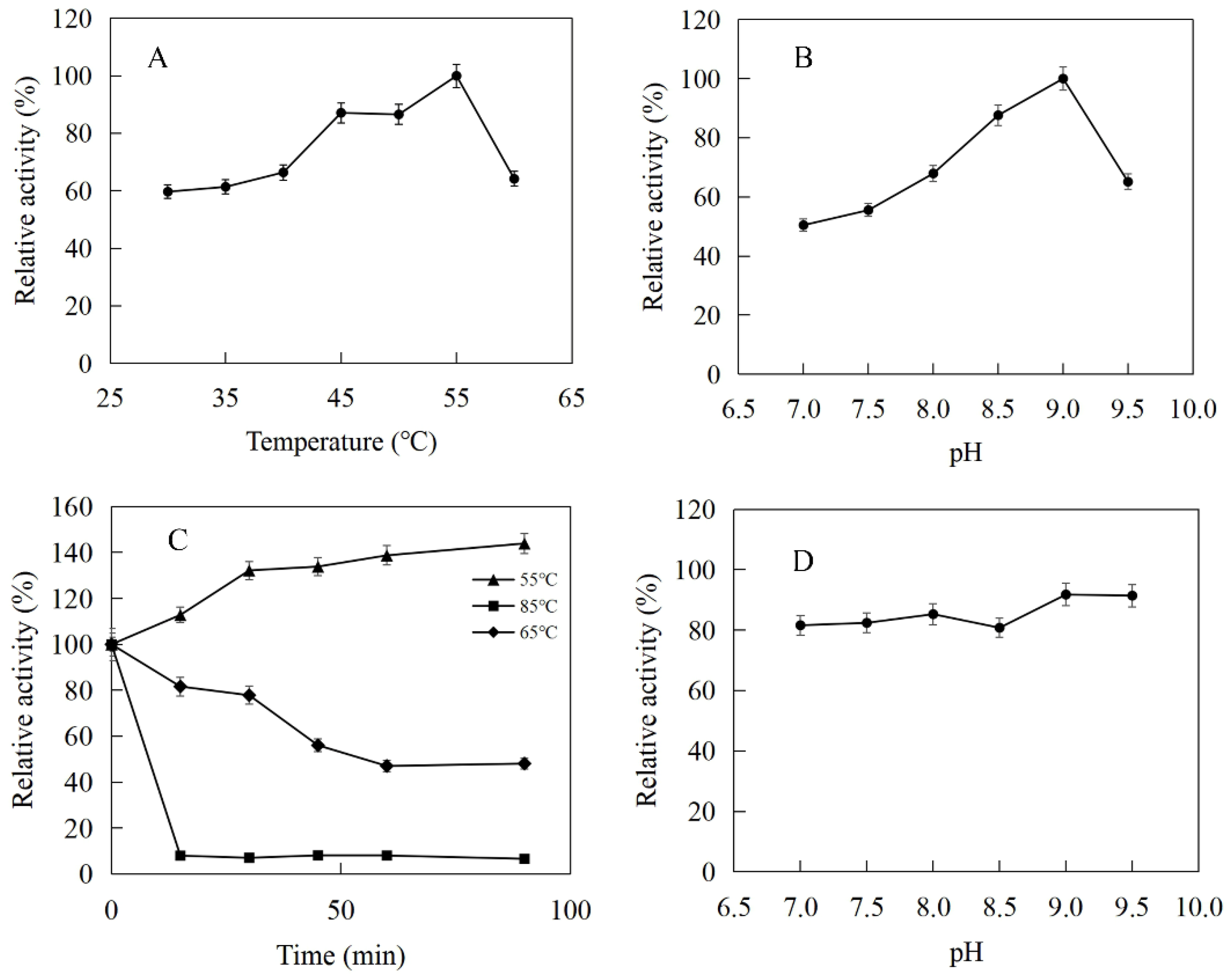
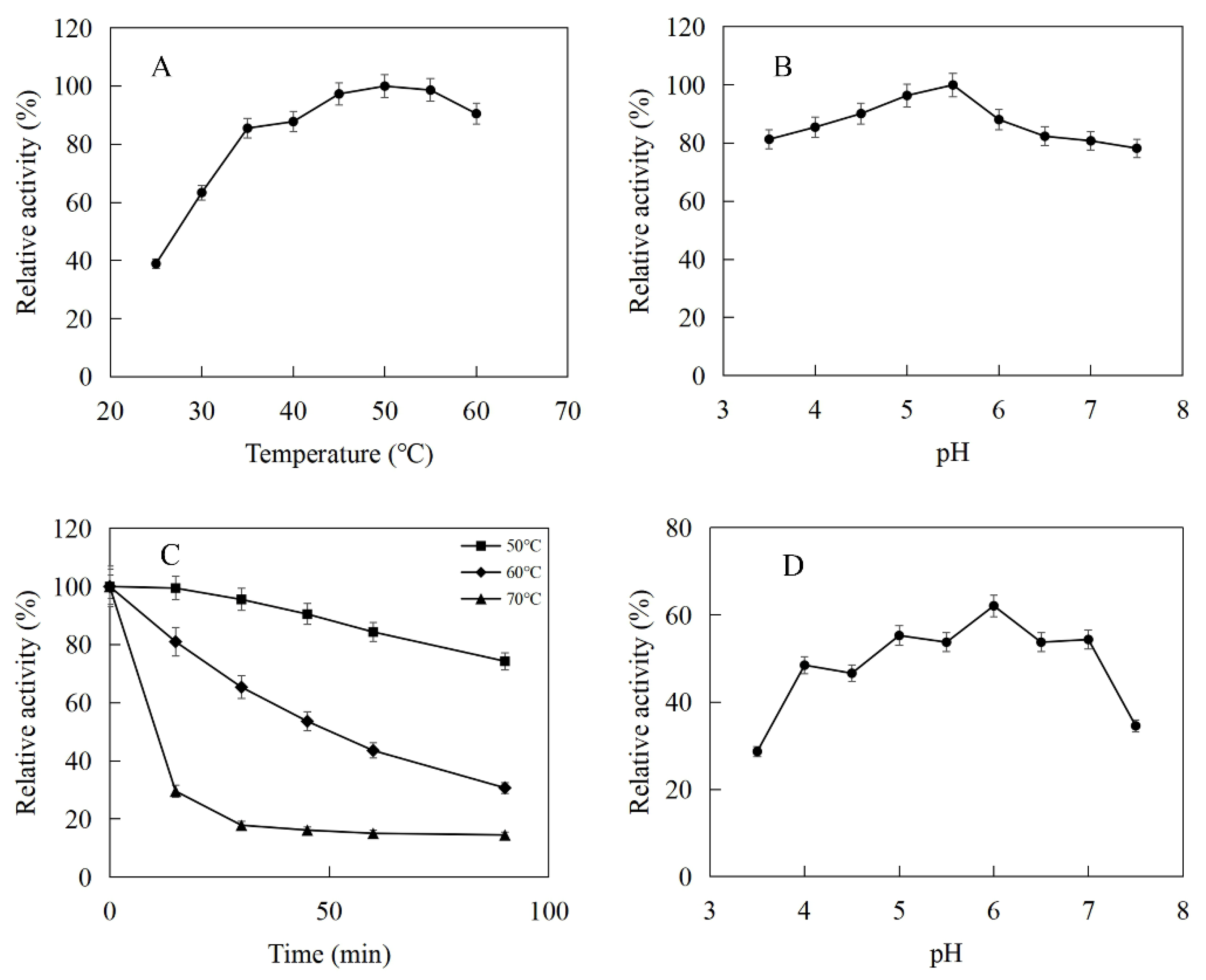

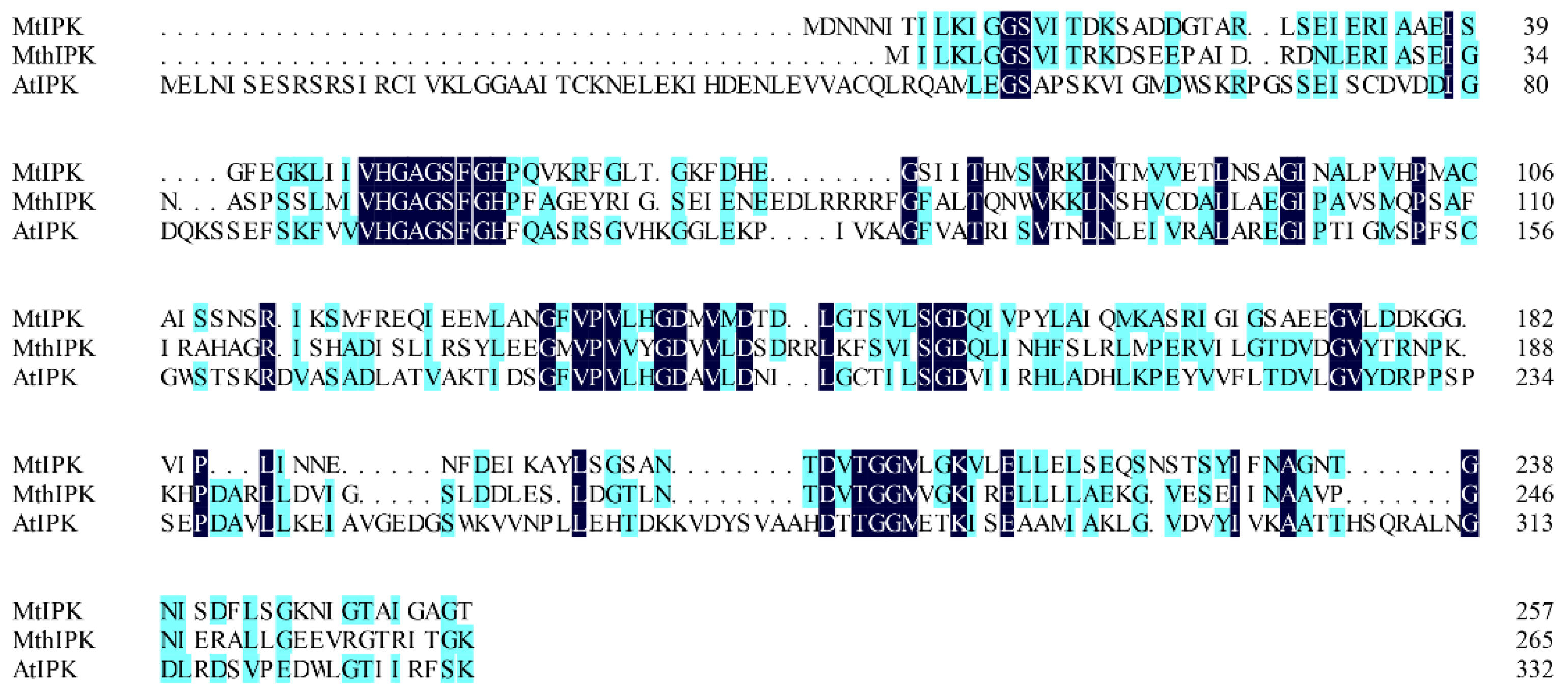

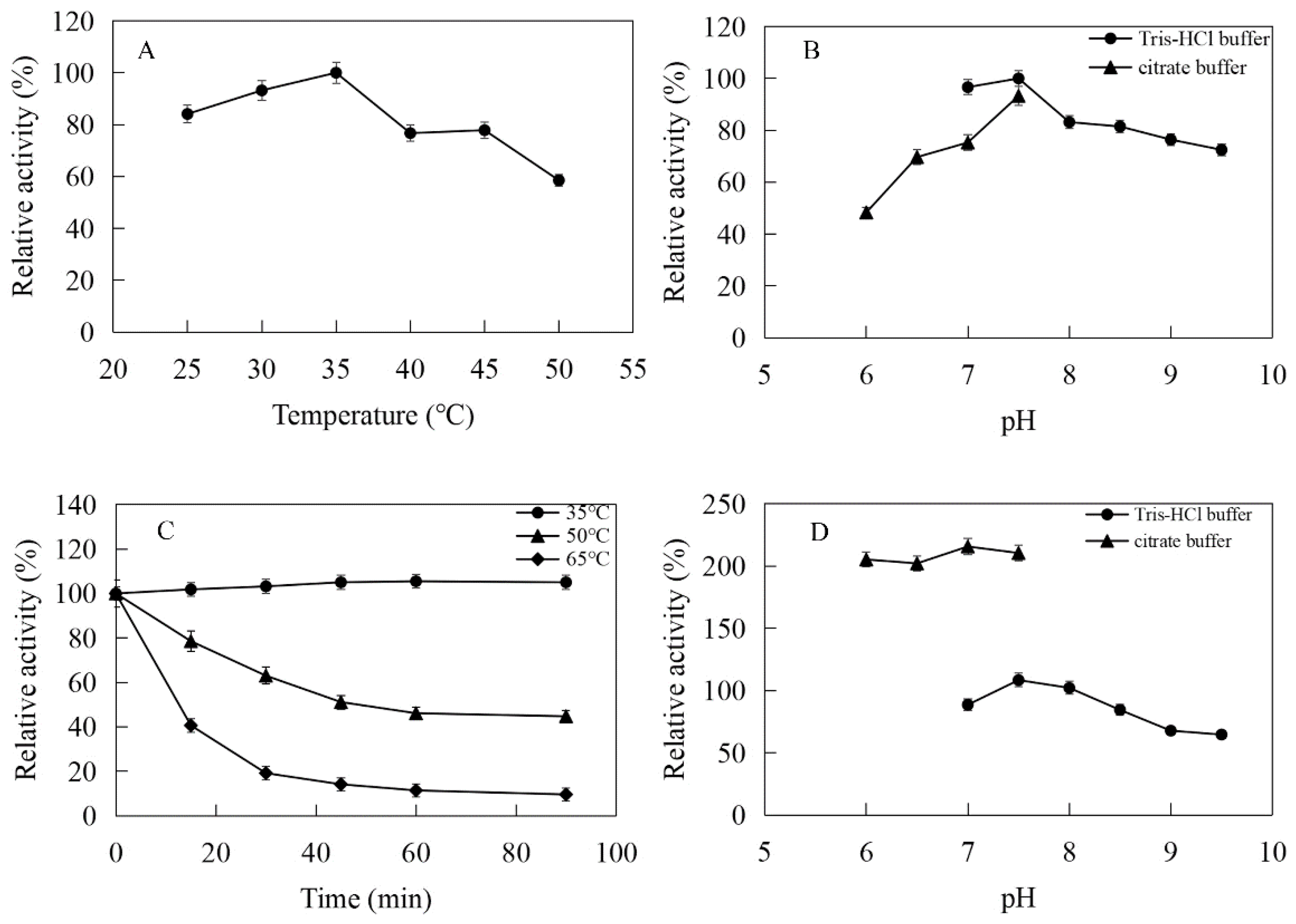
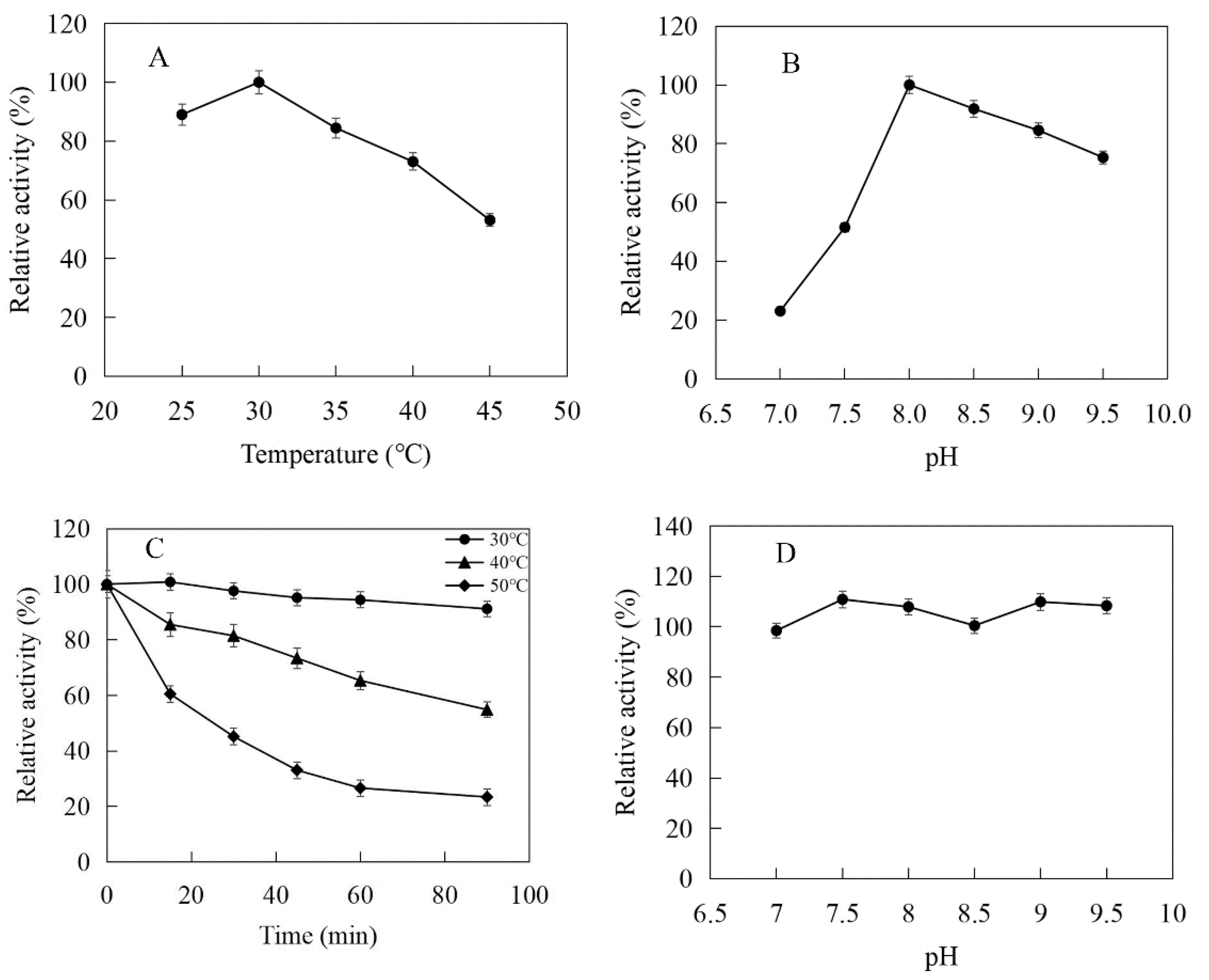
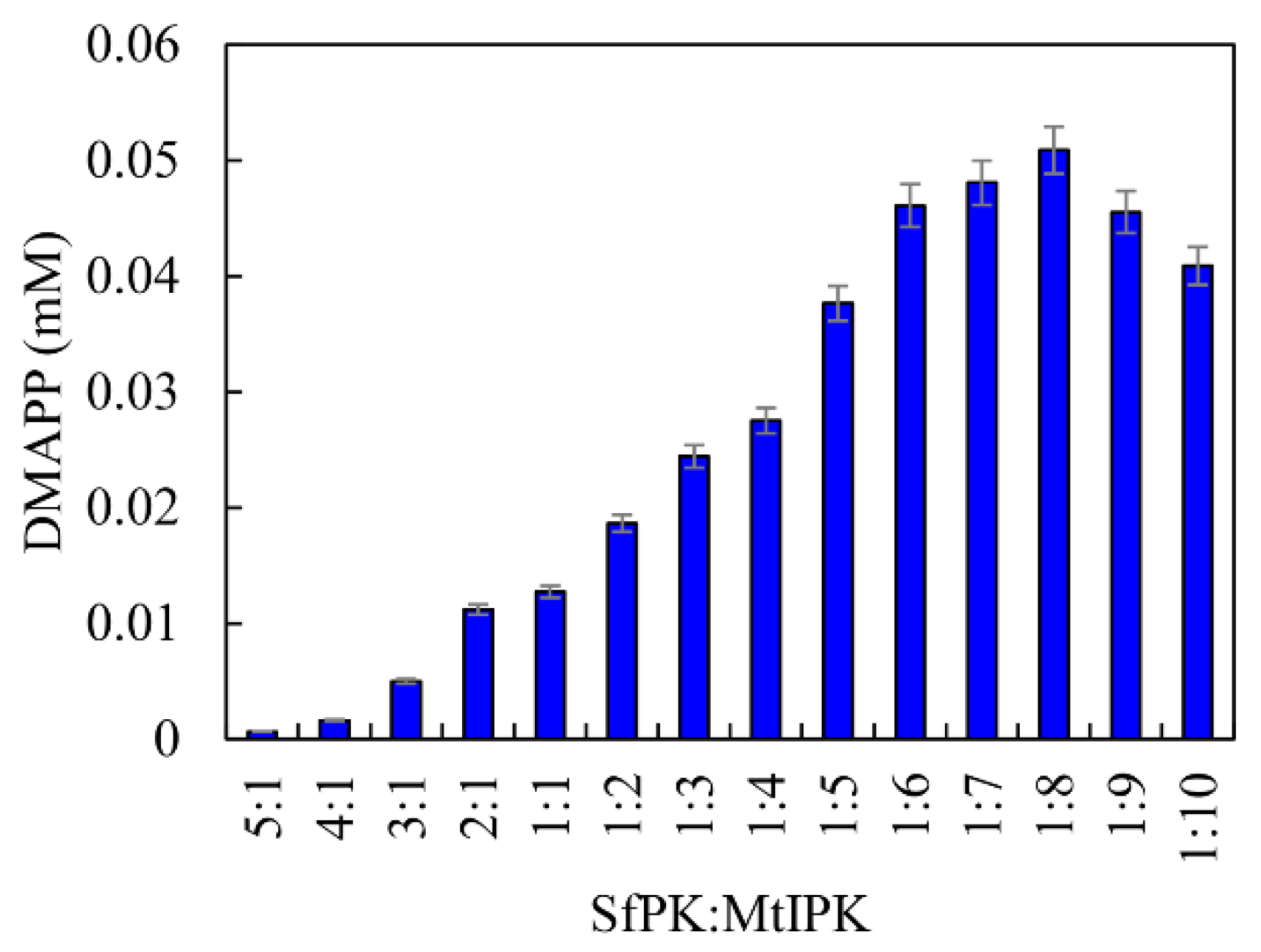

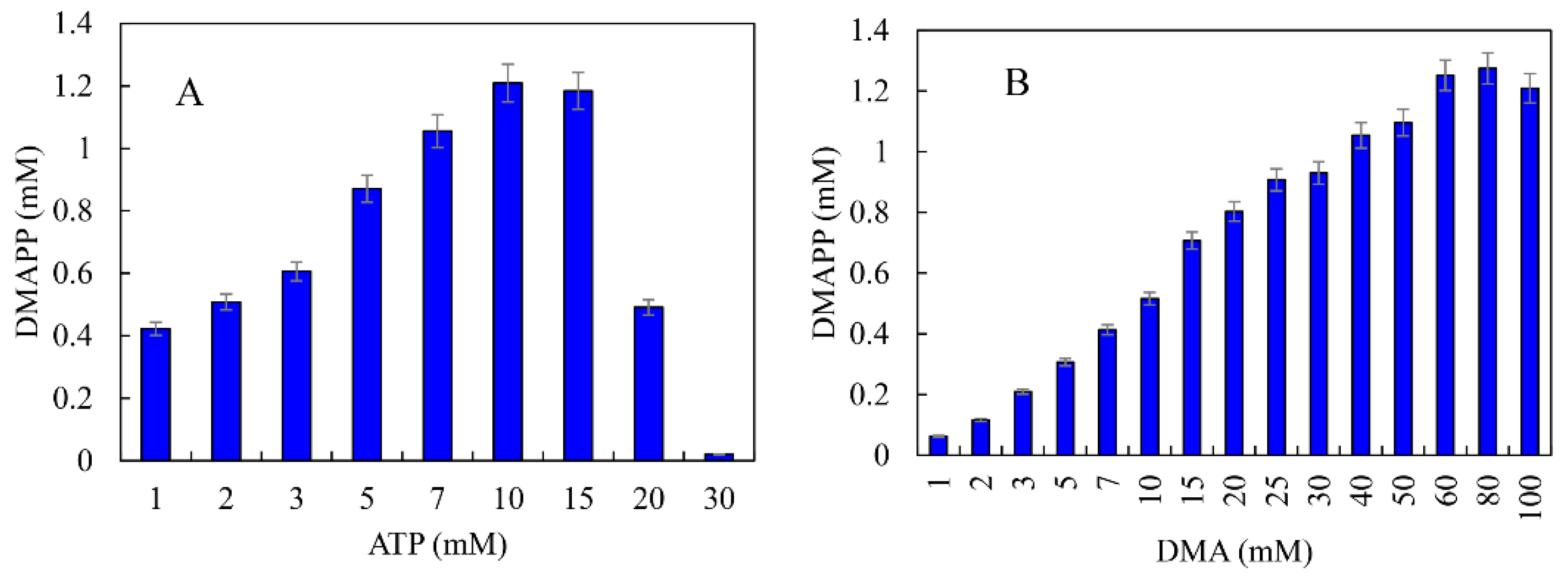

| Enzyme | Step | Total Protein (mg) | Total Activity (U) | Specific Activity (U/mg) | Yield (%) |
|---|---|---|---|---|---|
| SfPK | Cell extract | 478 | 15.3 | 0.032 | 100 |
| Ni-NTA affinity | 56 | 10.7 | 0.19 | 69.9 | |
| EcPK | Cell extract | 452 | 2.3 | 0.005 | 100 |
| Ni-NTA affinity | 13 | 1.3 | 0.1 | 56.6 | |
| ScPK | Cell extract | 278 | 18.1 | 0.065 | 100 |
| Ni-NTA affinity | 18 | 8.5 | 0.47 | 46.9 | |
| MtIPK | Cell extract | 489 | 2.7 | 0.0056 | 100 |
| Ni-NTA affinity | 4 | 0.18 | 0.045 | 6.6 | |
| MthIPK | Cell extract | 463 | 0.5 | 0.001 | 100 |
| Ni-NTA affinity | 21 | 0.34 | 0.016 | 68 |
| Cation | Residual Activity (%) | ||
|---|---|---|---|
| SfPK | EcPK | ScPK | |
| Control | 100 ± 0.8 | 100 ± 0.4 | 100 ± 0.8 |
| Fe3+ | 46.8 ± 2.1 | 5.8 ± 0.5 | 32.9 ± 1.1 |
| K+ | 113.7 ± 1.2 | 79.1 ± 1.5 | 89.6 ± 0.8 |
| Ba2+ | 138.9 ± 3.1 | 46.9 ± 0.9 | 56.2 ± 2.6 |
| Sr2+ | 122.1 ± 1.6 | 66.6 ± 1.2 | 63.9 ± 1.9 |
| Ca2+ | 99.4 ± 0.4 | 64.3 ± 0.6 | 96.4 ± 0.4 |
| Cu2+ | 102.1 ± 0.8 | 68.4 ± 1.8 | 79.2 ± 0.8 |
| Ni2+ | 32.5 ± 1.4 | 87.5 ± 1.1 | 64.6 ± 0.7 |
| Co2+ | 105.7 ± 0.8 | 84.5 ± 0.8 | 33.2 ± 1.5 |
| Zn2+ | 32.5 ± 1.0 | 44.6 ± 1.2 | 70.7 ± 1.8 |
| Mn2+ | 90.0 ± 1.1 | 79.8 ± 0.5 | 81.2 ± 1.6 |
| Na+ | 110.5 ± 0.5 | 81.5 ± 1.1 | 106.9 ± 0.6 |
| Fe2+ | 80.5 ± 0.3 | 34.9 ± 0.9 | 52.6 ± 1.5 |
| Li+ | 102.1 ± 0.9 | 81.5 ± 1.3 | 62.8 ± 0.9 |
| Mg2+ | 182.9 ± 1.9 | 88.1 ± 1.2 | 113.8 ± 0.6 |
| Al3+ | 152.5 ± 1.4 | 86.3 ± 1.4 | 77.2 ± 1.4 |
| NH4+ | 118.5 ± 0.7 | 82.6 ± 0.8 | 73.5 ± 1.2 |
| EDTA | 96.3 ± 0.9 | 48.1 ± 0.9 | 46.1 ± 0.5 |
| Cation | Residual Activity (%) | |
|---|---|---|
| MtIPK | MthIPK | |
| Control | 100 ± 0.9 | 100 ± 1.1 |
| Fe3+ | 82.9 ± 1.1 | 101.6 ± 0.3 |
| K+ | 44.6 ± 0.5 | 104.2 ± 1.0 |
| Ba2+ | 96.0 ± 0.8 | 109.8 ± 0.7 |
| Sr2+ | 41.1 ± 0.2 | 87.0 ± 0.9 |
| Ca2+ | 104.0 ± 1.3 | 118.1 ± 1.5 |
| Cu2+ | 77.7 ± 0.8 | 105.7 ± 0.8 |
| Ni2+ | 86.3 ± 1.2 | 109.8 ± 1.2 |
| Co2+ | 46.9 ± 1.6 | 102.6 ± 0.6 |
| Zn2+ | 84.0 ± 0.5 | 106.2 ± 0.5 |
| Mn2+ | 95.4 ± 1.8 | 103.6 ± 0.4 |
| Na+ | 77.1 ± 1.1 | 105.7 ± 1.4 |
| Fe2+ | 58.9 ± 0.7 | 104.7 ± 0.8 |
| Li+ | 61.1 ± 0.4 | 105.2 ± 0.6 |
| Mg2+ | 101.7 ± 1.8 | 116.6 ± 1.3 |
| Al3+ | 76.0 ± 0.6 | 108.8 ± 0.5 |
| NH4+ | 66.3 ± 0.7 | 90.2 ± 0.7 |
| EDTA | 29.1 ± 1.6 | 46.1 ± 1.0 |
| Plasmid/Strain | Description | References |
|---|---|---|
| Plasmids | ||
| pCDFDuet-SfPK | pCDFDuet-1 carrying SfPK from Shigella flexneri. T7 promoter, CloDF13 ori; streptomycinr | This study |
| pCDFDuet-EcPK | pCDFDuet-1 carrying EcPK from Escherichia coli str. K-12 substr. MG1655. T7 promoter, CloDF13 ori; streptomycinr | This study |
| pET-28a-ScPK | pET-28a (+) carrying ScPK from Saccharomyces cerevisiae. T7 promoter, pBR322 ori; kanamycinr | This study |
| pCDFDuet-MtIPK | pCDFDuet-1 carrying MtIPK from Methanolobus tindarius. T7 promoter, CloDF13 ori; streptomycinr | This study |
| pCDFDuet-MthIPK | pCDFDuet-1 carrying MthIPK from Methanothermobacter thermautotrophicus str. Delta H. T7 promoter, CloDF13 ori; streptomycinr | This study |
| pET-28a-AtIPK | pET-28a (+) carrying AtIPK from Arabidopsis thaliana. T7 promoter, pBR322 ori; kanamycinr | This study |
| pETDuet-7-DMATS | pETDuet-1 carrying 7-DMATS from Aspergillus fumigatus. T7 promotor; ColE1 ori; ampicillinr | This study |
| pG-KJE8 | Carrying chaperone protein DnaK gene (dnaK), chaperone protein DnaJ (dnaJ), chaperone protein GrpE gene (grpE), chaperone protein GroES gene (groES), and chaperone protein GroEL gene (groEL); dnaK, dnaJ, and grpE were promoted by the araB promotor; grpES and groEL were promoted by the tetR promoter | TaKaRa Bio a |
| pGro7 | Carrying the groES and groEL genes; groES and groEL were promoted by the araB promoter | TaKaRa Bio |
| pKJE7 | Carrying the dnaK, dnaJ, and grpE genes; dnaK, dnaJ, and grpE were promoted by the araB promoter | TaKaRa Bio |
| pTf16 | Carrying the trigger factor gene tig; tig was promoted by the araB promoter | TaKaRa Bio |
| Strains | Escherichia coli BL21 (DE3) | New England Biolabs b |
| BL21-SfPK | BL21 (DE3) harboring pCDFDuet-SfPK | This study |
| BL21-EcPK | BL21 (DE3) harboring pCDFDuet-EcPK | This study |
| BL21-ScPK | BL21 (DE3) harboring pET-28a-ScPK | This study |
| BL21-MtIPK | BL21 (DE3) harboring pCDFDuet-MtIPK | This study |
| BL21-MthIPK | BL21 (DE3) harboring pCDFDuet-MthIPK | This study |
| BL21-AtIPK | BL21 (DE3) harboring pET-28a-AtIPK | This study |
| BL21-7-DMATS | BL21 (DE3) harboring pETDuet-7-DMATS | This study |
| BL21-AtIPK- KJE8 | BL21 (DE3) harboring pET-28a-AtIPK and pG-KJE8 | This study |
| BL21-AtIPK-pGro7 | BL21 (DE3) harboring pET-28a-AtIPK and pGro7 | This study |
| BL21-AtIPK-pKJE7 | BL21 (DE3) harboring pET-28a-AtIPK and pKJE7 | This study |
| BL21-AtIPK-pTf16 | BL21 (DE3) harboring pET-28a-AtIPK and pTf16 | This study |
Publisher’s Note: MDPI stays neutral with regard to jurisdictional claims in published maps and institutional affiliations. |
© 2022 by the authors. Licensee MDPI, Basel, Switzerland. This article is an open access article distributed under the terms and conditions of the Creative Commons Attribution (CC BY) license (https://creativecommons.org/licenses/by/4.0/).
Share and Cite
Qiu, C.; Liu, Y.; Wu, Y.; Zhao, L.; Pei, J. Functional Characterization and Screening of Promiscuous Kinases and Isopentenyl Phosphate Kinases for the Synthesis of DMAPP via a One-Pot Enzymatic Cascade. Int. J. Mol. Sci. 2022, 23, 12904. https://doi.org/10.3390/ijms232112904
Qiu C, Liu Y, Wu Y, Zhao L, Pei J. Functional Characterization and Screening of Promiscuous Kinases and Isopentenyl Phosphate Kinases for the Synthesis of DMAPP via a One-Pot Enzymatic Cascade. International Journal of Molecular Sciences. 2022; 23(21):12904. https://doi.org/10.3390/ijms232112904
Chicago/Turabian StyleQiu, Cong, Yang Liu, Yangbao Wu, Linguo Zhao, and Jianjun Pei. 2022. "Functional Characterization and Screening of Promiscuous Kinases and Isopentenyl Phosphate Kinases for the Synthesis of DMAPP via a One-Pot Enzymatic Cascade" International Journal of Molecular Sciences 23, no. 21: 12904. https://doi.org/10.3390/ijms232112904
APA StyleQiu, C., Liu, Y., Wu, Y., Zhao, L., & Pei, J. (2022). Functional Characterization and Screening of Promiscuous Kinases and Isopentenyl Phosphate Kinases for the Synthesis of DMAPP via a One-Pot Enzymatic Cascade. International Journal of Molecular Sciences, 23(21), 12904. https://doi.org/10.3390/ijms232112904






